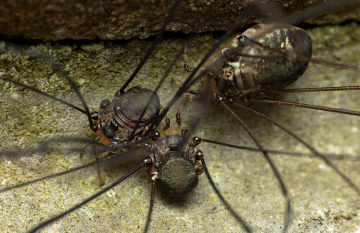Summary for Leiobunum sp. A (Opiliones)
previous species | next species
National Distribution
Terms of Use. Double-click on map to go to region

Explore Regional Distribution
Please log on and add a note on this species
About this species
Recorded altitude range5m to 131m
Species text
DistributionThis is an, as yet, unnamed species of Leiobunum (see Wijnhoven et. al. 2007) which has been spreading through Europe. It was first identified in Britain from Nottinghamshire in 2009 and this population appears to have persisted (see: www.eakringbirds.com). Its UK range is expanding rapidly and has also been recorded in north-west England, the Midlands, London and South Wales. In August 2021 it was first recorded in Ireland (Dublin).
It Europe it was first found in the Netherlands (in Ooij, east of Nijmegen) in 2004. It also occurs in Germany, Austria and Switzerland.
Habitat and ecology
According to Wijnhoven (2009) Leiobunum sp. A is associated with stony ground. It is also found in ruderal places (e.g. disturbed areas) and around houses, on walls, under window sills and gutters, by former brickworks and old brick ovens, by rivers, under bridges, concrete blocks and the like.
Adults occur from late June to late December with the greatest activity in September. They probably overwinter in the egg stage. The obvious behavioural characteristic of this species is its gregariousness - forming roosting aggregations of between fifty and a thousand individuals. These roosts often occur on, and inside, buildings.
Little information has been published on the prey of this species but is likely to include a very wide range of invertebrates. A major concern is that it may (as in the case of Opilio canestrinii) pose a threat to native species of harvestmen.
This large invasive species would make a good candidate for studying species interactions as it establishes and spreads.
Status
Recent introduction.
References
http://www.eakringbirds.com/eakringbirds3/arachnidsleiobunumsp.htm
Wijnhoven, H., Schönhofer, A. L. & Martens, J. 2007. An unidentified harvestman Leiobunum sp. alarmingly invading Europe (Arachnida: Opiliones). Arachnologische Mitteilungen 34: 27-38.
Wijnhoven, H. 2009. De Nederlandse hooiwagens (Opiliones) Naturalis Biodiversity Centre - Entomologische Tabellen, The Netherlands. (translation available here: http://srs.britishspiders.org.uk/portal/p/Harvestman+Resources)
References
Account last edited by Meg Skinner at 18:11 on Fri 25th Nov 2022.
Adult Season
Habitats
background methodology
Recorded management for locations with Leiobunum sp. A
Recorded substrate and hydrology for locations with Leiobunum sp. A
Images
please log on and upload a new image for this speciesSee also A-Z Species Index - A-Z Picture Index - previous species | next species



